Horror Classics: The Vampire Lovers
Hammer's first lesbian vampire movie is still great!
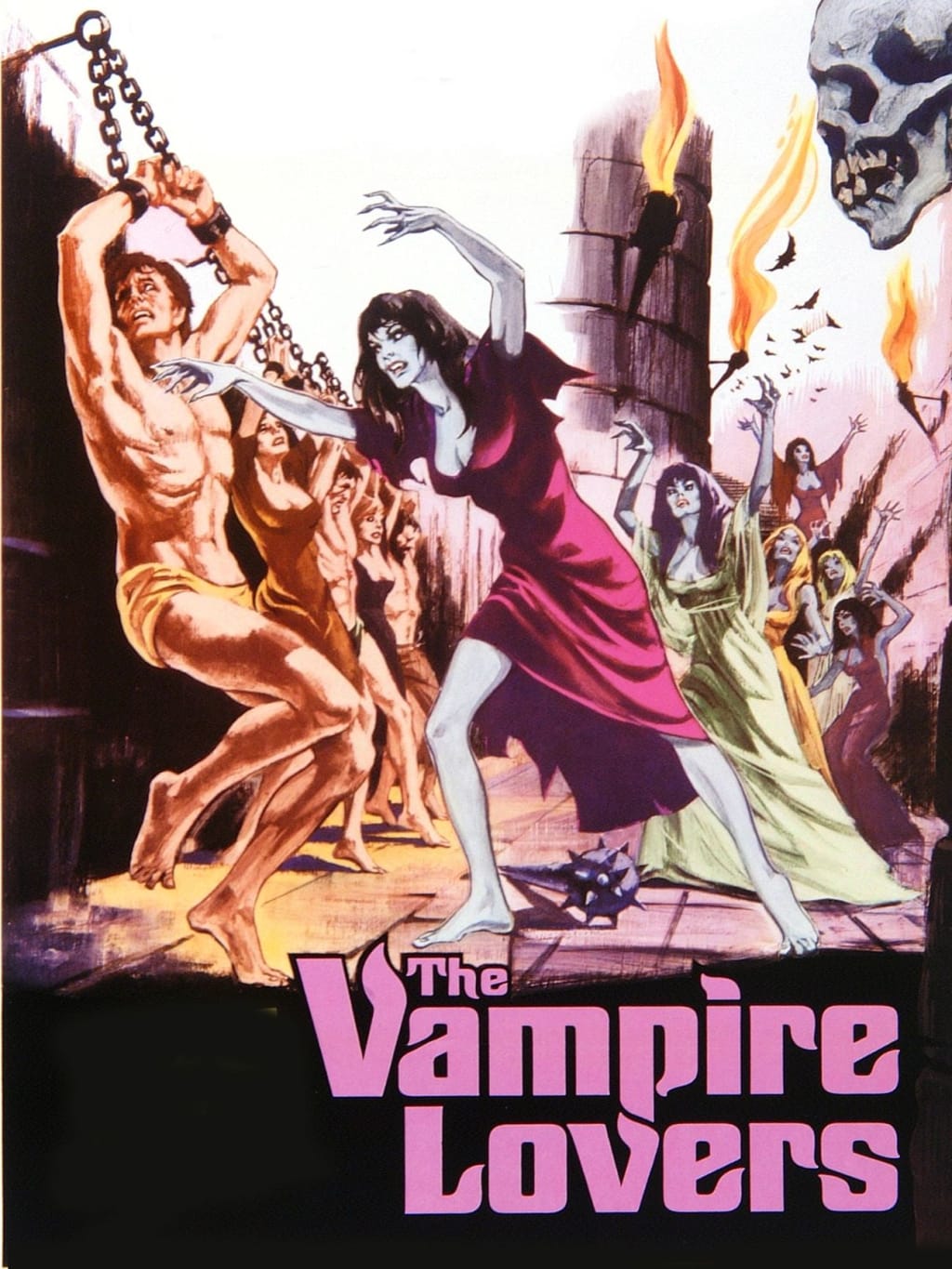
I love horror movies and I especially love the old Hammer horror movies of the 1950's and 60's. For this reason, I figured I'd take a look at some of my favorite classic horror movies. Yes, for those wondering, this is a new series; I need something different to write about and horror movies is the topic I've chosen.
So, what's the first entry into the Horror Classics series? Well, I said old Hammer movies were a favorite so I picked one from their repertoire: The Vampire Lovers. This is going to be a long one so strap in and grab some coffee and a snack!
Please note that there will be spoilers ahead as I'll be discussing the film in detail. There we go; with the spoiler warning out of the way, let's take a look at this 70's gem and see just how well it holds up to modern film standards.
The Story
A visiting Countess and her alluring daughter, Marcilla, arrive at a party hosted by a general Spielsdorf. Following a visit from a mysterious man in black, the Countess has to leave and the general takes Marcilla in as a guest. The general's niece, Laura, starts having terrible nightmares and gradually becomes weaker and weaker until she eventually dies; leaving her uncle heartbroken.
Not long after Laura's death, her friend Emma Morton encounters Marcilla (now calling herself Carmilla) and the Countess when their carriage breaks down. Once again, the mysterious beauty is taken in by the Morton family and Emma becomes the vampire's next target.
In a bid to save her, Emma's father joins a vengeful Spielsdorf and a skilled vampire hunter - Baron Hartog - to find and kill the creature before she can claim another victim.
Behind the Scenes of The Vampire Lovers

The Vampire Lovers is loosely based on Carmilla, an 1875 short story by J. Sheridan Le Fanu - more on this later. The film was produced by Hammer Studios and co-produced by American International Productions and was, at the time, much bolder than its contemporaries in its more explicit depictions of lesbian themes. This more sexually explicit depiction was something that the producers - Harry Fine and Michael Style - were warned about by the chief censor at the time. This is something I'm going to have to come back to.
Production began on January 19th, 1970 with the release date set at August of that year. The film was made at Elstree Studios in London and on the property of the Moor Park Mansion in Hertfordshire. Just as a quick side note: the pictures of the mansion in question are absolutely amazing!
Filmed on a budget of 165,227 pounds (around $200,000), the film was released in the UK on October 4th, 1970 and in USA just a few weeks later on October 22nd. As far as the box office is concerned, and I have to go off of the numbers from the AFI Catalog here: after several weeks in American theaters, The Vampire Lovers grossed $151,675 in box office returns. A quick check of a currency converter brings that dollar amount to roughly 121 million pounds - although I do have to point out that these numbers are in relation to modern exchange rates. These are impressive numbers either way.
Reception-wise, the film got mixed reviews with critics praising the set design and Roy Ward Baker's directing but criticizing the script by Tudor Gates as 'flat' which I think is fair enough.
What Works?
The Opening Scene
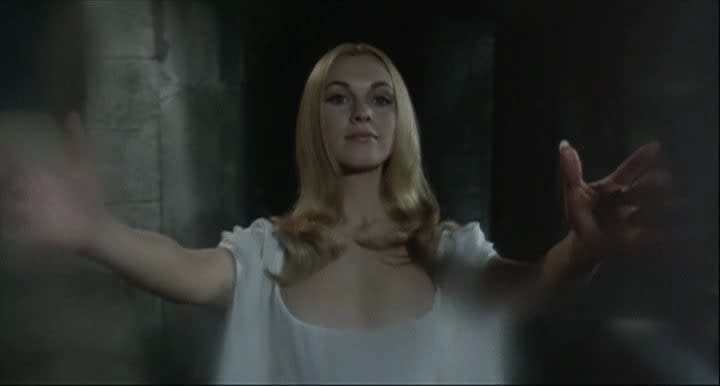
The film opens with a narration by the baron Hartog:
"I place this memorium card in the pages of my history, and the book is closed; I pray forever."
He then narrates how he lay in wait to kill the vampires of the Karnstein family and adds to a bit of vampire lore; that if the burial shroud were to be removed, the vampire would be unable to return to its resting place.
The first vampire that we see in the film is played by Kirsten Lindholm. She's onscreen for about five minutes or so before being killed and while she isn't around for long; her death sticks with you for a while. The reason being; she doesn't look dangerous at all. She looks like a perfectly normal and attractive woman; so when she bares her fangs and is subsequently killed it's a bit of a shocker. With this scene, we're launched into the film properly and it's one of those rare instances where instead of expository dialogue; we get to SEE what's going on. A perfect example of the 'show, don't tell' rule.
The Performances (1)

The performances are great! To say that The Vampire Lovers boasted one heck of a cast would be an understatement. In spite of the oftentimes flat script, everyone brought their A game to the table. Peter Cushing is fantastic as Gen. Spielsdorf; portraying a man broken by the loss of his niece and out for vengeance. Pippa Steele's Laura is likable - considering how little time we get with her as an audience. Ferdy Mayne's portrayal of the doctor in this film is perfectly balanced.
As good as these portrayals are, however, there are four standout performances in this picture. Those of Kate O'Mara, Madeline Smith, Ingrid Pitt and Douglas Wilmer. There are also, rather unfortunately, some painfully underused characters - but we'll get to those.
Madeline Smith plays Emma, the second of Carmilla's main, sort of love interest characters (after Laura). Emma is the daughter of an Englishman, as I said before, and she's seemingly wholly innocent to the ways of the world. She's vulnerable and scared but empathetic and gentle. Between them Smith and Pitt share some fantastic chemistry. There is some undeniable tension between the two of them with Carmilla being the more forthright and almost openly pursuing Emma and the latter being slightly uncomfortable but not really aware of what's being implied.
Ingrid Pitt, who plays Carmilla, is stunningly beautiful and she has a very commanding presence onscreen. Your eyes are drawn to her the second she's on screen and she absolutely steals every scene that she's in. Her portrayal of Carmilla is also the most...complex that I've seen. I'd even go as far as to say that there hasn't really been a vampire character as complex since. The reason I say this is her performance is seemingly all over the place. She's aloof and distant, then gentle and caring, then ferociously predatory; taking delight in killing, and finally vulnerable and lonely.
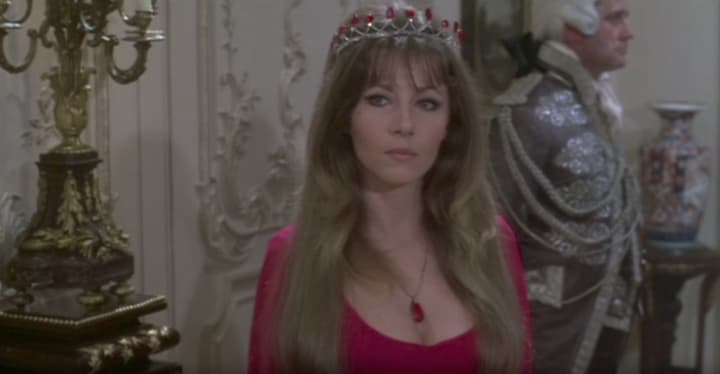
There are moments where she's very distant, almost distracted; but then she'll get angry at something simple i.e. at one point Emma is talking about Laura's death and Carmilla eventually snaps at her telling her to stop talking about it. There are moments where she is seductive and then she switches to intimidating; the perfect example is where Mademoiselle Perrodot (now under the vampire woman's spell) tells Renton, the butler, that he's worrying over nothing. Carmilla is standing right behind him with this cold look on her face - almost as if to say:
"don't you dare."
Brutal Kills
There are three kills that stand out to me: Renton, the doctor and the governess.
Renton gets the doctor against the orders of Perrodot and the doctor does his thing before leaving. Carmilla kills him in the woods a short while later to prevent him from returning.
The next one to face her wrath is Renton himself. The butler starts out loyal to the Morton family but eventually falls under Carmilla's spell; giving in to his lust for her and having Emma's room cleared of garlic flowers (placed there earlier) and the cross around the girl's neck removed. When he goes to claim his reward, Carmilla easily kills him in what's probably the second most brutal kill in the film; making him believe that he was about to have the best sex of his life before sinking her fangs into him and draining his blood.
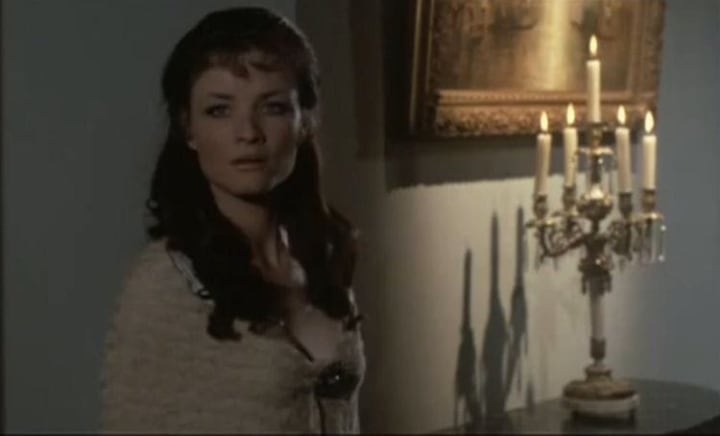
Mademoiselle Perrodot probably gets the worst possible deal in this film. As Carmilla is taking Emma away, and the governess pleads to go with them. She's kneeling at the top of the stairs crying while Carmilla approaches. At first it seems like there might be a show of mercy as the vampire slowly cradles the sobbing woman in her arms. As the governess relaxes a bit she sees the vampire's fangs and screams in despair as she's drained of her blood.
This final kill is where we see an almost tragic element to Carmilla. She's had moments throughout the film where she appears to genuinely love Laura and, later, Emma. She takes great care not to let Emma in particular see her kill. This is why when Emma screams in horror at the sight of her governess' death; Carmilla looks up with a look of absolute horror on her face. It's like she forgot Emma was there for a second and is horrified at having revealed her darker nature to the innocent object of her desires. One review that I looked up described it perfectly: it's like she desperately wants to have a companion in Emma but is condemned by her dark nature to an eternity of solitude.
An Interesting Death for a Vampire
The Vampire Lovers boasts one of the more interesting staking scenes I've ever seen in a vampire movie which is saying a lot. While Carmilla was trying to take Emma away, Spielsdorf, Hartog and Emma's father have gone to the Karnstein castle - Carmilla's ancestral home. As they're prowling the grounds looking for the vampire's grave, they spot her heading inside and follow her; finding her ruby necklace on the floor in the dining hall. When they locate her casket and take it to the castle's chapel, Spielsdorf agrees to stake her himself. He takes the stake from Hartog, lines it up and then hesitates for a moment before driving it through Carmilla's heart. That moment of hesitation echoes Douglas Wilmer's portrayal of Hartog almost perfectly.

As they hunt for Carmilla's resting place, the baron recounts how he'd lain in wait for a vampire and then worked through the night staking every vampire in the castle grounds until his strength gave out. Where the general's hesitation fits in is with the tone in which the baron's story is delivered. He isn't bragging, he's not proud of what he's done; he's weary and just wants to get on with his life - dealing with the trauma he'd suffered that night in his own way.
The interesting part about Carmilla's death scene is that she doesn't fight back. The sun hasn't come up yet and she does wake up as they pull her shroud back; but she makes no effort to stop the general from staking her. It's almost like she's resigned herself to the fact that she can't have the connection she wants. She doesn't want to be alone and miserable anymore, so she allows the general to stake her.
Production Design
The Vampire Lovers, much like the other films that Hammer had produced up to that point, had a very small budget. This smaller budget, however, certainly doesn't seem to have impacted the film much at all. The sets are fantastic and the costumes are amazingly vibrant. The music is great and is used sparingly so as not to overwhelm the audience - something we can all appreciate, I'm sure.
There's also a deep atmospheric sense to each set piece and Roy Ward Baker hits every beat almost perfectly.
Minimal Gore
The special effects on display here are dated - there's no getting around that but with that said; they hold up reasonably well. A lot of the work was done practically which I love and the gore that the Hammer films had become known for in previous films was largely underplayed. There's a bit of blood here and there and the sight of the doctor's body after he's killed is pretty gnarly but beyond that there really isn't all that much gore here. Although, I suppose you could make the argument that Hammer was trying to up the ante in regards to sexual content and so focused on the lesbian aspect of the film...I can't complain about that.
What doesn't Work?
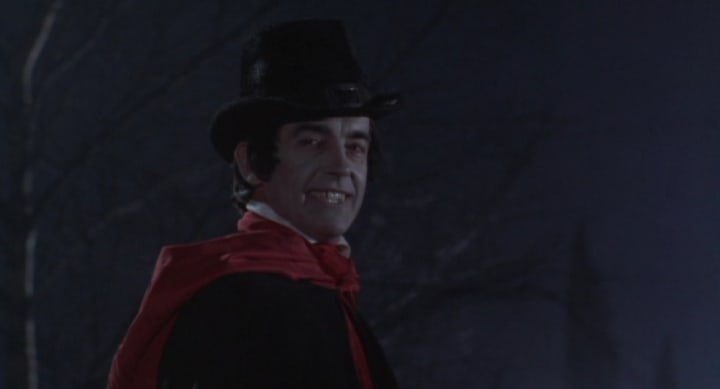
The Writing
One criticism leveled at the film is that the writing feels flat and uninteresting. This is something that I can somewhat agree with. At the end of the day, the film's story isn't all that engaging; there's just nothing really there. It doesn't help that the dialogue sometimes slips into the cliched period horror territory and feels oddly forced in places as a result.
The Performances (2)
Performance-wise, nobody was really bad; just severely underutilized. I'll start with the character of Laura. Like I said before, the little time that we get to spend with Pippa Steele's character is enough for us to like her. We do like her and we feel bad when she dies; sympathizing with the heartbroken Spielsdorf. Unfortunately, Laura disappears very quickly from the film; almost as though the producers were anxious to get Ingrid Pitt and Madeline Smith together. This isn't normally an issue, except that here the film feels repetitive as a result. Carmilla is left in the care of a family and tears that family apart. This is problematic but bearable.
John Forbes-Robertson's and Dawn Addams' characters of the Man in Black and the Countess aren't bad but they just don't have any impact. Usually a character will leave a mark of some sort to say:
"Hey, I was here."
In this case, that doesn't happen. Dawn Addams is beautiful and she has a definite presence when she's on screen. Unfortunately, she appears only twice in the film and both times it's to drop Carmilla off at each of her two victims' homes. With that said, Addams does a great job in leaving a small impression on the audience; it's just a shame she didn't have more to do.
The Man in Black seems to serve as a sort of grim reaper-type character portending the death of someone. He also appears to be a vampire but there's nothing to him. He appears a total of three times in the film and does absolutely nothing! This is something of a cardinal sin when it comes to storytelling. There's no reason for him to be in the film at all apart from, maybe, adding an extra layer of mystery. The problem with that is that there's no resolution to that mystery. This lack of payoff leaves viewers frustrated as they try to figure out who this guy is and what he's doing.
The really sad part is that both the Countess and the Man in Black could've been so much more interesting.
The Vampire Lovers as an Adaptation

So, I mentioned before that the head censor at the time warned the producers about the lesbian themes. The producers pointed out that the lesbian themes were a part of the source material and not their own doing. This prompted the censor to back down. So, let's discuss the source material.
Carmilla was written by J. Sheridan Le Fanu and published in 1872 in his short story collection - In a Glass Darkly. The story follows a teenage narrator, Laura as she's preyed upon by a female vampire. In that regard, the film is remarkably faithful to the book but there are several changes.
The Changes
- The film leaves out the odd dream that Laura has at the start where she sees Carmilla for the first time. The two later recognize each other from similar dreams.
- The carriage accident that brings Carmilla to Emma/Laura is the same in both the original story and the film but the film leaves out the strict instructions regarding secrecy related to her family and her 'daughter' that the Countess gives before departing to visit a dying relative.
- We never actually see the general's party in the book. We learn of it later. Likewise, the general's niece never actually appears in the story - outside of a letter from her uncle - having died of a mysterious illness. This means that, in the film, Emma is fulfilling the role of Laura.
- Carmilla's real name is Mircalla in both versions but in the book her first alias is Millarca - not Marcilla. Admittedly this is more of a nitpick than anything else.
These are just a few changes and some of them work quite well. Carmilla's first alias being changed from Millarca to Marcilla is one example: 'Marcilla' just sounds better. Leaving out Laura's odd dream about Carmilla from the start of the story is also, in my opinion, a good choice because even in the book it felt out of place. Having Emma and Laura be friends in the film is also a good choice; it gives us a reason for Emma's distress at her passing that's more than the rather bland reaction that Laura gave in the book.
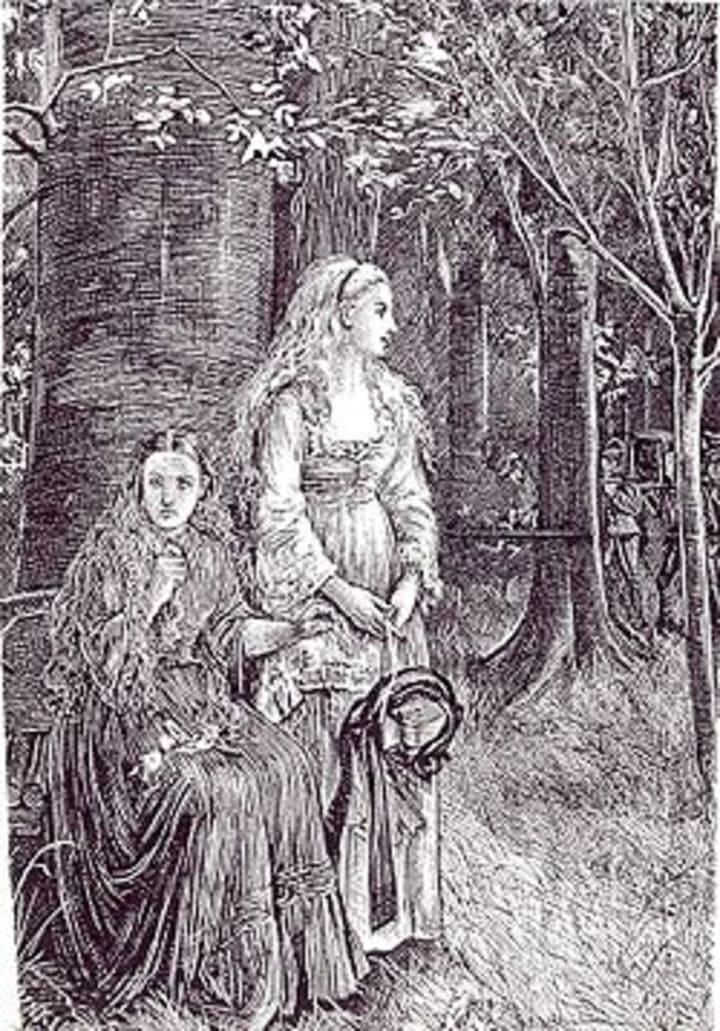
Making Emma and Laura friends does, however, lead to a bit of a sluggish pace where the film just drags its heels for a bit. As I mentioned earlier Carmilla basically does the same thing twice making the film feel repetitive.
As an adaptation, the film is very faithful to the book - even with the more overt sexuality and nudity. It may be considered to be tame by today's standards but The Vampire Lovers still holds up very well against modern day films. Carmilla's fangs look natural, a look that has been improved over the years; often leading to an overly polished appearance. The nightmare sequences are still great, I'd go as far as to say that these sequences are some of the better nightmare scenes in horror cinema.
The depiction of lesbianism here is done, for lack of a better word, tastefully. I may be in a minority with this opinion but it seems to me that the cast and crew genuinely tried to make a horror movie featuring lesbian themes without demonizing anyone's sexual preferences.
Final Thoughts
The Vampire Lovers came out at a time when Hammer was struggling to stay relevant. The company's Dracula and Frankenstein films were being poorly received and it seemed that audiences had grown tired of the various monsters and sequels. In spite of its mixed reception, the film was successful enough to warrant two sequels; Lust for a Vampire and Twins of Evil - both released in 1971. These three films were labeled as 'The Karnstein Trilogy' and while they were good; the general feeling was seemingly that Hammer was running out of steam.
That said, the film's strict adherence to the 'show, don't tell' rule is something that even a jaded modern audience can appreciate.
Well, this was a fun piece to do and it's the longest review I've written on Vocal to date. I hope you guys enjoyed it, like I said at the very start of this article; this is a new series that I want to try. The next two will wrap up the Karnstein Trilogy and we'll take it from there.
Fun Fact: Ingrid Pitt had to use chewing gum to keep her vampire fangs in place so that they wouldn't fall into Kate O'Mara's cleavage during the scene where O'Mara's character - Madame Perrodot - is attacked and killed by Carmilla.
About the Creator
Greg Seebregts
I'm a South African writer, blogger and English tutor; I've published 1 novel and am working on publishing a 2nd. I also write reviews on whatever interests me. I have a YouTube Channel as well where I review books, and manga and so on.


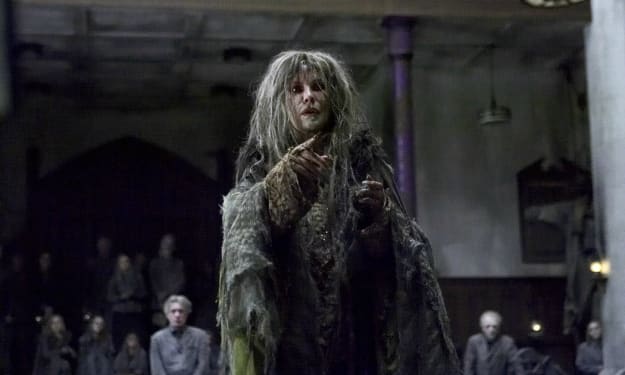



Comments
There are no comments for this story
Be the first to respond and start the conversation.